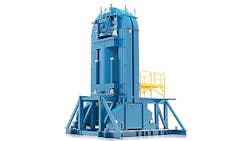Alcoa Adding Hot-Isostatic Pressing for Jet-Engine Parts
Alcoa has outlined another major investment in aerospace manufacturing capability, this time involving a $22-million hot-isostatic pressing system to be installed at its investment casting operation in Whitehall, MI. The aluminum producer said the investment would help it to address aerospace manufacturers’ "growing demand" for jet-engine components in titanium and nickel.
The new machine also will support Alcoa’s increasing production of 3D-printed parts for jet engines.
The installation is expected to be available to begin qualifying finished parts by 2016. Alcoa did not indicate a supplier for the new installation.
Hot-isostatic pressing, or HIP, is a thermal forming process in which heat and pressure are applied to cast products (e.g., turbine blades, engine structural parts) simultaneously in a controlled sequence, aiming to improve the mechanical and structural properties of the component.
For 3D-printed parts, the HIP process can increase the material density of powdered metals, thereby achieving more strength and consistency, and promoting longer service life.
“All titanium, 3D-printed and some nickel parts used for jet engines must be treated using the HIP process,” according to Alcoa’s announcement.
Alcoa already operates eight similar systems at Whitehall, which it calls “one of the world’s largest HIP technology complexes for aerospace.” It said the new installation would allow it to process its largest jet-engine parts isostatically.
Over the past two years Alcoa has invested billions in new manufacturing capabilities to supply aerospace customers with more and better jet-engine parts. It points to commercial jet manufacturing programs at Airbus and Boeing, as well as jet-engine manufacturers like GE Aviation and CFM International as evidence of rising demand for additional production capacity and process capabilities.
Specifically, it is expanding its investment casting capacity in LaPorte, IN, and Hampton, VA, and its aluminum-lithium alloy billet casting capability in Lafayette, IN.
The corporation also has acquired new capacity, including titanium producer RTI International Metals; aluminum and titanium investment caster Tital; and forger Firth Rixson Ltd., a firm that operates a related technology, isothermal forging.
“As aerospace growth soars, Alcoa continues to invest in the latest technologies, creating added capacity to capture fast-growing demand,” stated exec. vice president Olivier Jarrault. “Combined with our expansions in LaPorte, IN, and Hampton, VA and our growing 3D printing capabilities, this investment will give Alcoa the broadest capabilities to deliver high-quality titanium, nickel and 3D-printed parts for the world’s bestselling jet engines.”
About the Author
Robert Brooks
Content Director
Robert Brooks has been a business-to-business reporter, writer, editor, and columnist for more than 20 years, specializing in the primary metal and basic manufacturing industries. His work has covered a wide range of topics, including process technology, resource development, material selection, product design, workforce development, and industrial market strategies, among others.
